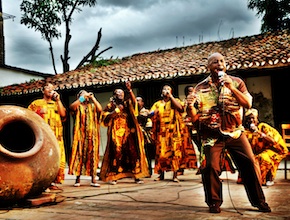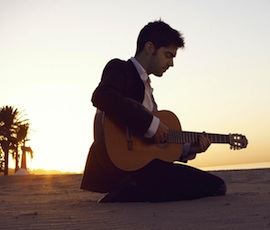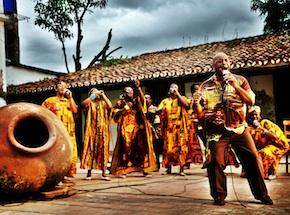Number 1 in the Series: Music and the Sacred
Music has been integral to religious and spiritual practice for thousands of years, across the globe, and sacred and devotional music still permeates contemporary society, in various forms.In this Series, SFCV explores how such music is created, shared, and showcased today, and its significance to musicians and listeners.
Three years ago, Karim Baer decided to extend his duties as director of public programs for the California Institute of Integral Studies (CIIS) to the creation of a performing arts series. After several seasons, he knew he must be doing something right when he witnessed Judie Wexler, the CIIS academic vice president, rise from her seat among the hundreds attending a series concert at the Herbst Theatre in San Francisco and start dancing to the beat of Viver Brasil.
Featured Video
“And she comes from very mainstream academia,” Baer points out during a chat in a tea lounge. The CIIS, headquartered on San Francisco’s Mission Street, has long given a different meaning to the term higher education, offering unfamiliar approaches to graduate study in spirituality and healing practices. “But I’m confident that even a Financial District advisor or broker, who goes out and sees a lot of art and music, thinks about his or her job in a different way, and sees connections that someone else wouldn’t,” Baer continues. “And I think every doctor should pull out his pad and prescribe, ‘Go see a concert this week’ or ‘Go move your body.’”
This year’s CIIS series kicks off this Friday with a performance of contemporized mantras by Deva Premal & Miten, at the Palace of Fine Arts, and continues through May 2012, covering a broad range of regions, musical genres, and ethnic and spiritual backgrounds, in concerts divided between the Palace and Herbst.
Baer, now 36, was recruited to CIIS from Seventh Body Awareness, a yoga studio he’d been managing in Berkeley. He brought with him an interest in the classical musics of Persia and India, fueled by his studies in the Sufi sect of Islam, which he’d begun as a teenager. (He received the name “Karim” from a sheikh; it means “generous” in Arabic.) “The Sufis were always somewhat rebellious, and found a lot of religious expression through music,” he notes.
“I think every doctor should pull out his pad and prescribe, ‘Go see a concert this week’ or ‘Go move your body.’” – Karim Baer
Baer’s spiritual approach resonated with his new employer’s. The CIIS was founded in 1968 by the Indian scholar Haridas Chaudhuri, who’d worked alongside Alan Watts to import Eastern spiritual and philosophical thought to the West. Over time, the Institute added programs in psychology to those in Asian and “comparative” studies. After receiving accreditation from the Western Association of Schools and Colleges, as well as funding from Laurence Rockefeller (grandson of John D.), master’s and doctoral programs were launched in philosophy and in studies outside the orbit of most colleges: cosmology, women’s spirituality, somatic psychology, drama therapy, expressive arts therapy, integrative health, transformative leadership, and community mental health. Among the faculty attracted to this alternative approach to academia was Ralph Metzner, a psychotherapist and author who’d helped pioneer the exploration of psychedelics at Harvard.
From Indian Classical to Creole Cuba

“We’ll always have classical Indian music, because I feel like it’s paying homage to our roots,” says Baer about his series offerings. He’d begun eight years ago with annual appearances by Coleman Barks, an exponent of the 13th-century Sufi saint Rumi, and by tabla master Zakir Hussain. Then, “I decided we needed to have a formal performing arts program that would fit a specific niche within San Francisco. There was world music happening in other programs, but there wasn’t one place where world music, or sacred music from around the world, was really being featured” in an ongoing context.
Aside from this week’s season opener, the Institute’s inclination toward the East will be reflected in a concert on February 2 at Herbst by Iranian-born Kayhan Kalhor, playing the kamancheh, a Persian spiked fiddle, as he sings the poetry of Rumi in the original Farsi. On May 5, at the Palace, 76-year-old G.S. Sachdev will perform Hindustani classical music on the bansuri flute, accompanied by Marin-based tabla teacher Swapan Chaudhuri.
Baer says he’s particularly looking forward to the sound of the kamancheh, which he’d first witnessed at a Sufi gathering in Kansas City. “It brought me more into the moment than anything else I’d ever heard,” he remembers. “And I think that’s the gift of Indian and Persian classical musics: to be very transportive, but to also really bring you into the here and now.”
Still, “I don’t think the East has a copyright on the Inner Life,” Baer advises. “Anytime someone has given their life to mastering an art form, and people on the receiving side really give themselves to receiving it, there’s an opportunity to find the Inner Life there.” He refers to this season’s second concert, on October 15 at Herbst, which is likely to include Bach, Albéniz, Granados, and other Western repertoire, “though you could say it’s world music in that ‘exotified’ sense, because [classical guitarist] Miloš Karadaglić comes from Montenegro, and basically grew up in that war-torn country.”
“I hate the term ‘world music’ anyway, because all music is world music, and when we use that term, we tend to exotify everything that’s not Eurocentric.” – Karim Baer
The Creole Choir of Cuba follows at the same venue on November 3, 2012. “I like that there’s this whole history of the African diaspora,” says Baer, noting that the choir members, who perform in a French patois, are descended from Haitians who migrated across the Caribbean. He also points out about the choir’s dynamic presentation that “Not all the Inner Life is silent. There’s a part which is celebrative and joyful and expressive.”
“E Pluribus Unum” Via Music

On February 23, the charismatic Lila Downs, daughter of a Mexican Mixtec singer and a Scottish-American filmmaker (and herself a performer in films and on soundtracks), will celebrate her bicultural repertoire at Herbst Theatre. “One of the holes in our program has been that we hadn’t done anything for the Latino community,” Baer admits. “And I think if we’re gonna host this thing we’re calling ‘world music,’ we’d better become balanced as far as types of music we’re offering. I hate the term ‘world music’ anyway, because I feel like all music is world music, and when we use that term, we tend to exotify everything that’s not Eurocentric. I feel like our job is to represent the pluralistic identities of the United States.”
The Soweto Gospel Choir comes to Herbst on April 5 for its second appearance in the series. “They help create some healing around our own conversations about race in this country,” says Baer about this group of black South Africans. “Music becomes a way to tell the story of a culture, to bear witness to their journey and their suffering, as well as to celebrate their triumphs.” Last year at the Paramount Theatre in Oakland, the choir “had about 2,000 people out of their seats. But the other interesting thing was, it brought so many people together: immigrants from Africa, African-Americans devoted to Gospel, Euro-Americans interested in world music — and I think that’s one of our gifts as a presenting body. We’re not all one thing; we can bring different people together.”
On April 26, Vieux Farka Touré, son of the late Malian star Ali Farka Touré, appears at Herbst with his touring group. “He’s very lively, he’s being called ‘The Hendrix of the Sahara,’” reports Baer. “He’s definitely symbolic of taking the tradition, but also moving it forward, and using music to transcend differences.”
Baer hopes that sort of transcendence “can also inform the conversations about diversity that happen at the Institute,” and notes that among the student body at its three facilities — on Mission, Market, and Minna Streets — “there’s a strong African-American and Latino contingent, as well as Indian.” More and more students, faculty, and administrators are joining the general public at performances, and “there’s definitely a buzz in the Institute after a concert.”
Aside from informing diversity, Baer points out, music is integrated in the CIIS curriculum. “We actually have a whole certificate program in sound, voice, and music healing. And really, it’s looking at sound as a healing modality. We have very well-trained musicians who come into this program: David Darling, Glen Velez, and Meredith Monk have come as presenters.”
Despite his showcasing of global music stars, Baer encourages audiences to look beyond the stage, and inward. “I’ve found music to be an incredible vehicle for transporting oneself into one’s own Inner Life,” he testifies. “And maybe the paradox is, music needs silence, in a lot of ways. In Sufism, we find it through chanting and vocal techniques. But there’s also that moment in any concert, where you can viscerally feel a thousand people in a state of awe, that moment when the music’s ended, and you have a thousand people sitting there, absorbing the feeling. It’s just as important as the time leading up to it.”

